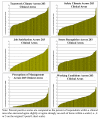The Safety Attitudes Questionnaire: psychometric properties, benchmarking data, and emerging research
- PMID: 16584553
- PMCID: PMC1481614
- DOI: 10.1186/1472-6963-6-44
The Safety Attitudes Questionnaire: psychometric properties, benchmarking data, and emerging research
Abstract
Background: There is widespread interest in measuring healthcare provider attitudes about issues relevant to patient safety (often called safety climate or safety culture). Here we report the psychometric properties, establish benchmarking data, and discuss emerging areas of research with the University of Texas Safety Attitudes Questionnaire.
Methods: Six cross-sectional surveys of health care providers (n = 10,843) in 203 clinical areas (including critical care units, operating rooms, inpatient settings, and ambulatory clinics) in three countries (USA, UK, New Zealand). Multilevel factor analyses yielded results at the clinical area level and the respondent nested within clinical area level. We report scale reliability, floor/ceiling effects, item factor loadings, inter-factor correlations, and percentage of respondents who agree with each item and scale.
Results: A six factor model of provider attitudes fit to the data at both the clinical area and respondent nested within clinical area levels. The factors were: Teamwork Climate, Safety Climate, Perceptions of Management, Job Satisfaction, Working Conditions, and Stress Recognition. Scale reliability was 0.9. Provider attitudes varied greatly both within and among organizations. Results are presented to allow benchmarking among organizations and emerging research is discussed.
Conclusion: The Safety Attitudes Questionnaire demonstrated good psychometric properties. Healthcare organizations can use the survey to measure caregiver attitudes about six patient safety-related domains, to compare themselves with other organizations, to prompt interventions to improve safety attitudes and to measure the effectiveness of these interventions.
Figures
References
-
- Kohn LT, Corrigan JM, Donaldson MS, (Eds) To Err is Human. Building a Safer Health System. Washington DC: National Academy Press; 1999. - PubMed
-
- Department of Health . Organisation with a memory. The Stationary Office, London; 2000.
-
- Reason JT. Managing the risks of organizational accidents. Ashgate Publishing, Aldershot; 1997.
-
- Maurino DE, Reason J, Johnston N, Lee RB. Beyond Aviation Human Factors. Ashgate Publishing, Aldershot;; 1995.
-
- Leape LL. Error in medicine. Journal of the American Medical Association. 1994;272:1851–1857. - PubMed
Publication types
MeSH terms
Grants and funding
LinkOut - more resources
Full Text Sources
Medical



